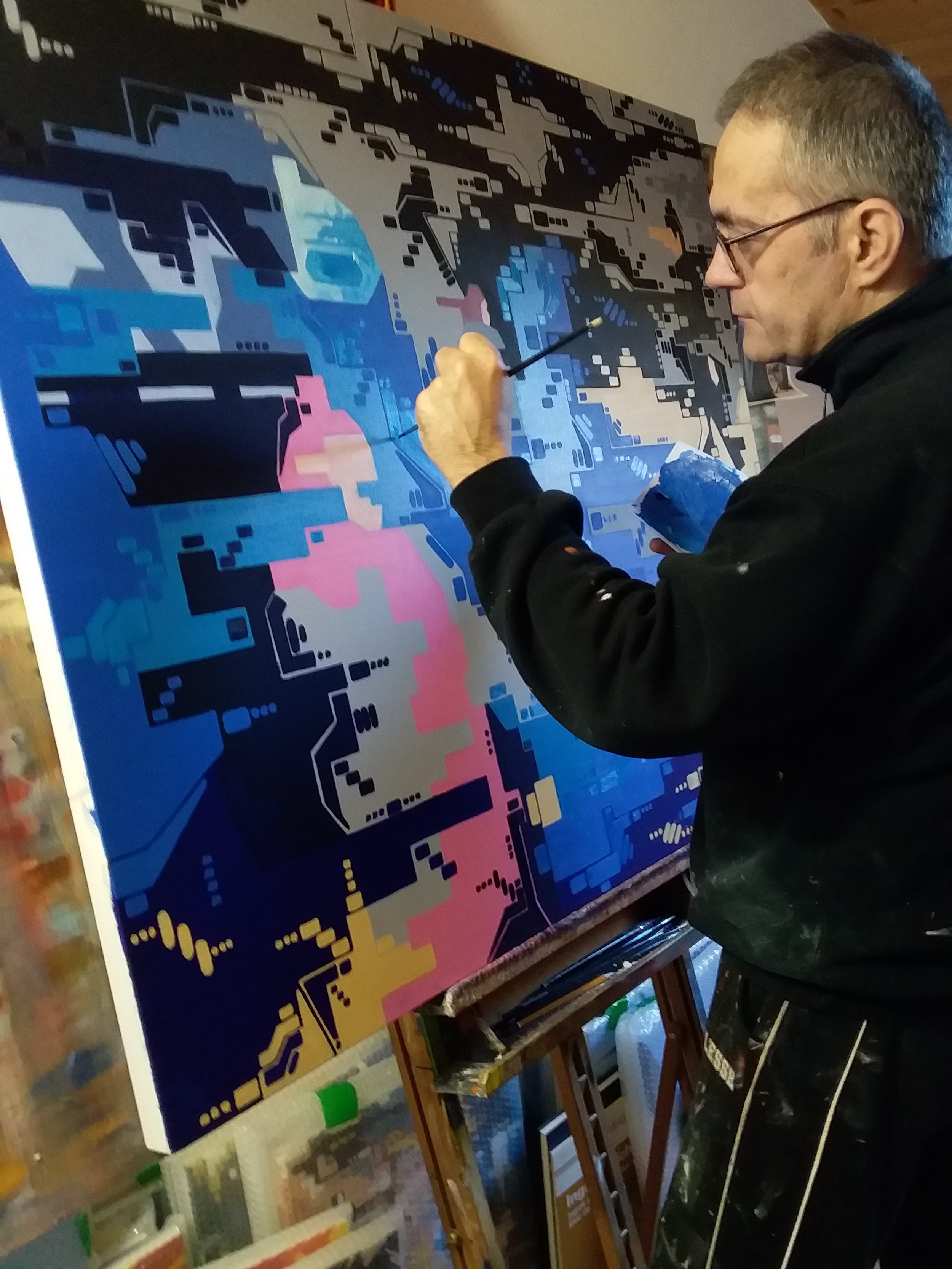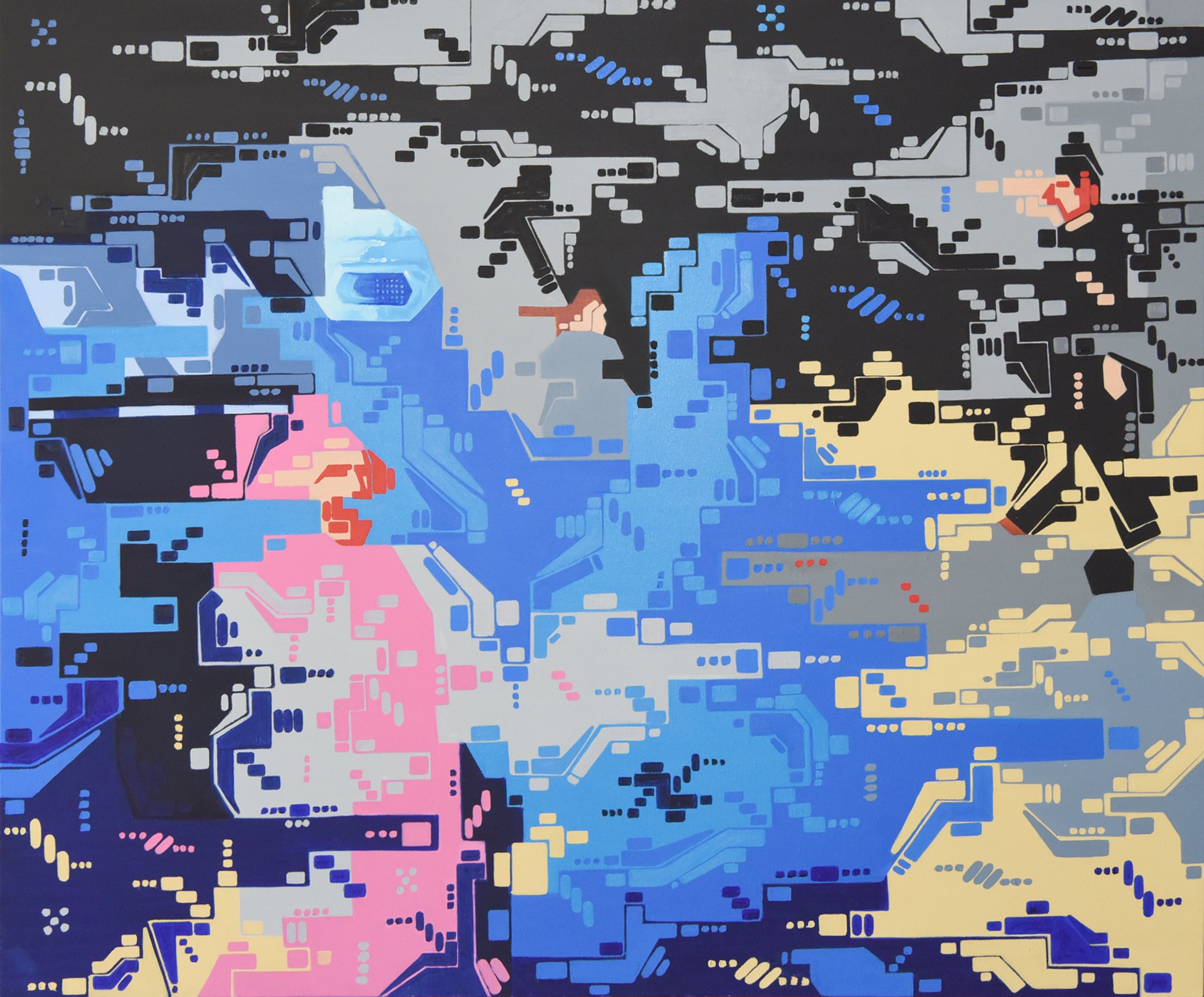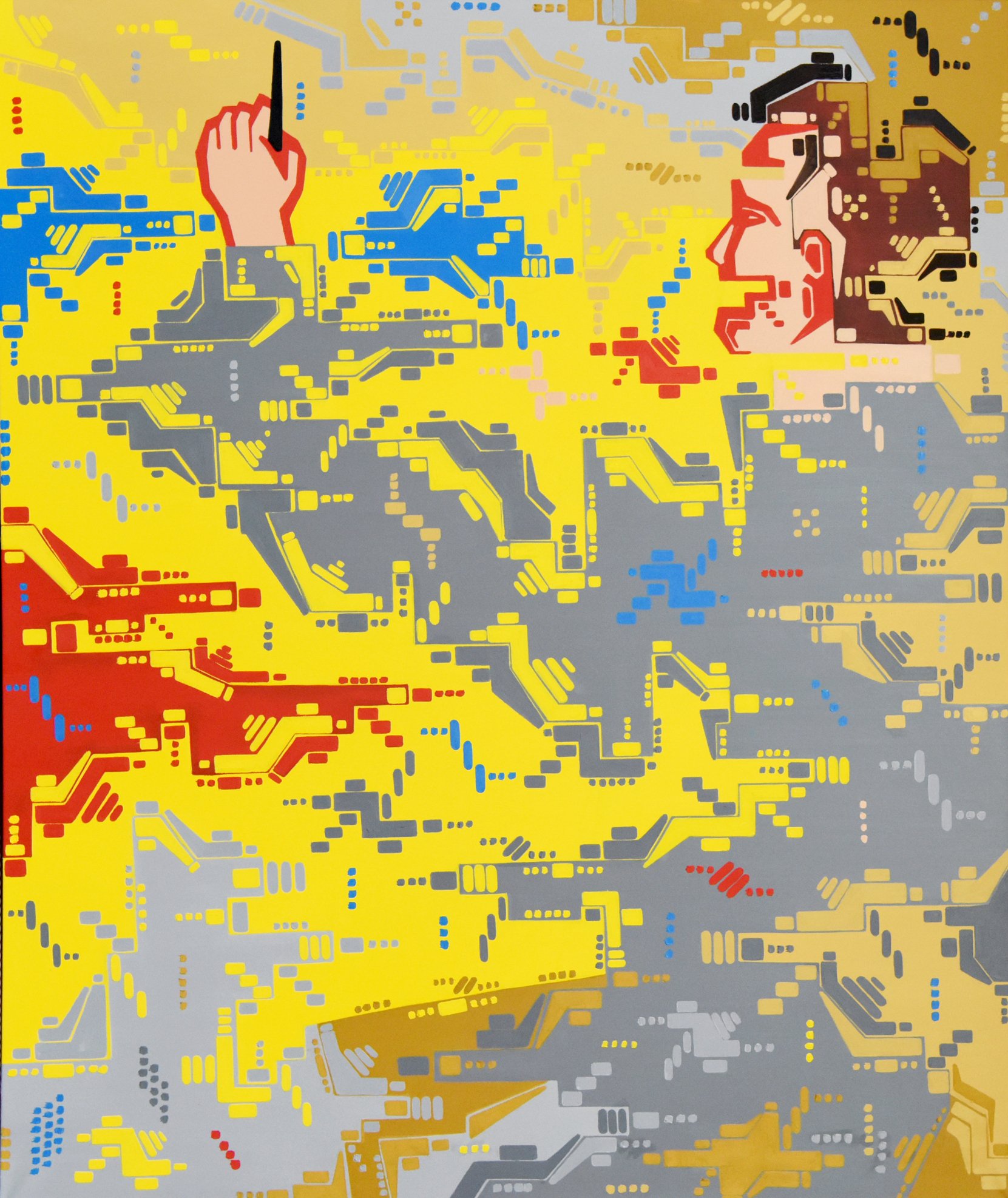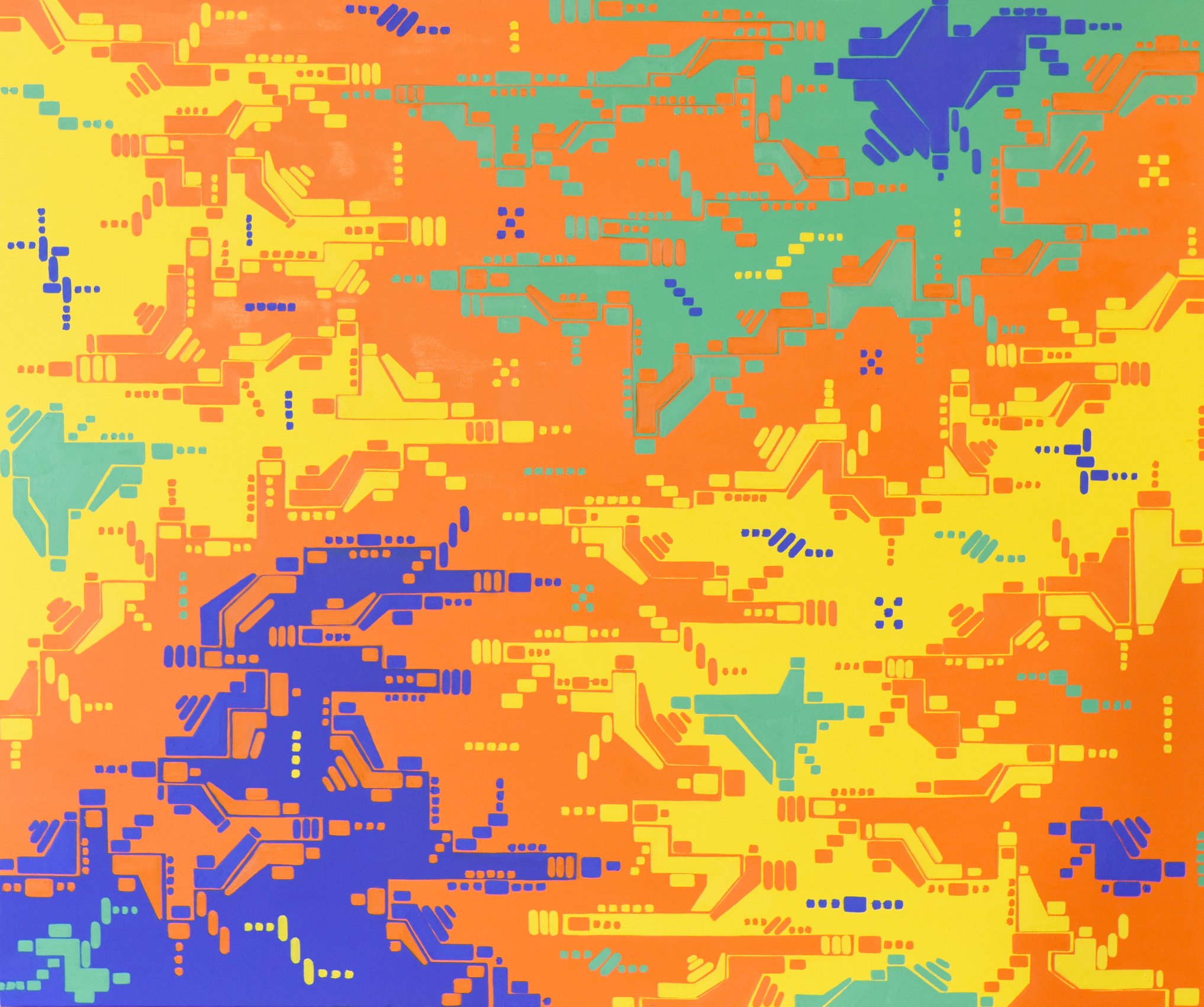Interview with Aurelio Gaiga
I have been painting since 1996.
In the first years I experimented freely in search of a personal style.
From 2007 to 2017 I worked on a rigorous geometric abstraction.
Since 2018 I have been creating works that investigate the growing importance that technology has assumed and will assume more and more in our lives.
I work on the deformation of images ( images of people seen in their daily lives reading a newspaper, drinking a coffee, ect… ) as in the case of television interference or digital distortions.
Some of these works only present these digital distortions as if they had taken over our reality, waiting for something new, that we don’t know.
Other works present interpretations of famous paintings of the past reinterpreted and modified in this key, as if technology were erasing our past, our history, our memory, perhaps our humanity.
All the works are characterized by vivid and intense colors, to represent the seductive and positive aspects with which each new technological discovery is presented, always leaving out any potential negative aspect.
Some works investigate current events at a political, social and economic level to demonstrate how technology can be used by authoritarian regimes and governments to limit individual freedoms.
When did you first become interested in art? Was there a specific moment or piece of art that ignited this passion?
Since I was a child, drawing was my favorite pastime.
As a teenager I began to occasionally hang out with a painter from my town : his name was Angelo Bertuzzi.
The subjects of his paintings were classic : still life, landscapes.
Sometimes he painted with his fingers, thus imparting his own personal style to his works.
Watching him work fascinated me.
Subsequently, while I was attending the Verona State Art High School, a visit to the studio of one of my figure professors made me understand definitively that I would try with all my might to become a painter.
What initially inspired you to focus on the theme of technology in your artwork? Was there a particular moment or experience that sparked this interest?
When I started this cycle of work in 2018, I was coming from a decade of rigorous geometric abstraction.
These works gave me the opportunity to express myself on an extremely current theme with implications on multiple levels : social, economic and political, as well as with ethical implications of considerable importance.
That is , I had the possibility of being an artist in my time.
Furthermore, I had greater possibilities both on a compositional and coloristic level.
How has your artistic style evolved over the years? Can you pinpoint any key influences or phases in this evolution?
I have been painting since 1996.
In the first decade I painted works alternating between abstraction and figuration, in complete freedom.
Then from 2007 until 2017 I worked on a rigorous geometric abstraction also influenced by the work of Paul Klee, an artist I love.
I remember that the first time I exhibited these works in a gallery in Verona, in 2010, the curator of the exhibition made more than one comparison with the work of Paul Klee, finding some similarities,
Then, in 2018 came the current work on the technology.
Is there a personal story or connection behind any of your artworks that you would be willing to share?
In my works, those inherent to daily activities such as reading a newspaper, drinking a coffee, ect…, my mother appears, although distorted.
Having family members or friends as subjects or as inspiration for your work is always convenient, even if sometimes it’s a little difficult to convince them.
Can you describe your artistic process? How do you incorporate elements of technology into your creative workflow?How do you think technological advancements have altered the landscape of artistic expression, particularly in painting?
My works always begin with a drawing.
The drawing is the basis : it may be obvious but for me it really is like that.
What I try to convey in my works are digital distortions ( as in the case of television interference ) which act on people and the environment, modifying them.
I’m not interested in a hyper-realistic rendering, I’m interested in just suggesting the idea.
I believe that current technological advances, in addition to producing overtly technological works ( I am thinking of the works of Refik Anadol for example ) in painting have produced the opposite result.
That is, a painting that echoes Surrealism as well as a return to figuration, to the representation of bodies, even deformed or post-human ones : the dream against hyper-rationality and technological control and physicality against the virtual.
In your opinion, how has the proliferation of technology affected society's perception and appreciation of traditional art forms like painting?
I believe that painting involves essential activities in the life of a human being such as drinking, eating, sleeping…
For me, painting is a human thing : the rendering of a thought on canvas.
I believe that in art what counts is what an artist says or tries to say more than the means with which he says it.
So if a work created with new technologies certainly has the novelty effect, it does necessarily have the validity of a thought.
Which instead can be ha d today as well as in the future in a painting on canvas or a drawing on paper.
What are some of the challenges you face when trying to depict the complex nature of technology and its impact on human life in your paintings?
The main challenge I face is trying to say that not everything in technology is as beautiful and positive as is always underlined with every new technological invention.
I believe that the greatest danger is the loss of our past, our history, our memory and perhaps, our very humanity.
Do you have a favorite piece that you've created on this theme? Can you tell us more about it and the message you intended to communicate?
One of my favorite works is the one in which I portray my mother in the mirror ( Interference 42 – in the mirror ).
It recall the “Narcissus” attributed to Caravaggio which is reflected in the water.
Here, however, the subject is completely distorted, the face and a hand can barely be made out and the mirror does not reflecting anything humanly recognizable.
How do you find audiences generally react to your artwork? Are there any interpretations or responses that have surprised you?
At the social network level (Instagram ), I receive good appreciation in the form of “likes”.
Unfortunately I have not yet been able to physically exhibit these works in a gallery and therefore I have not been able to have direct contact with an audience.
I hope to be able to do so in the near future.
Where do you see the intersection of technology and art heading in the future? Do you predict any specific trends or shifts in how artists will use technology?
To date, no one can yet say with certainty what could happen in the world of art with the help of artificial intelligence.
Finding true, authentic art will probably increasingly difficult.
We should all be as good as Ulysses in not letting ourselves be deceived by bewitching sirens.

















